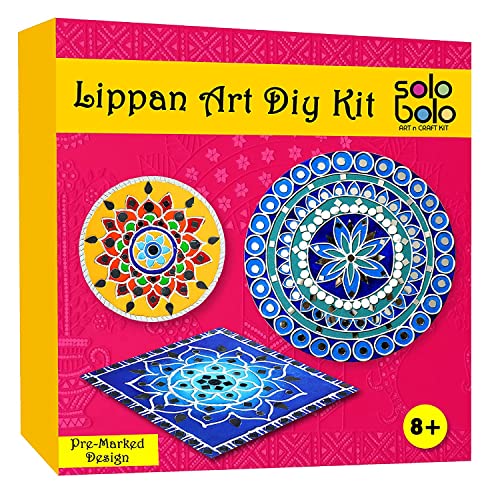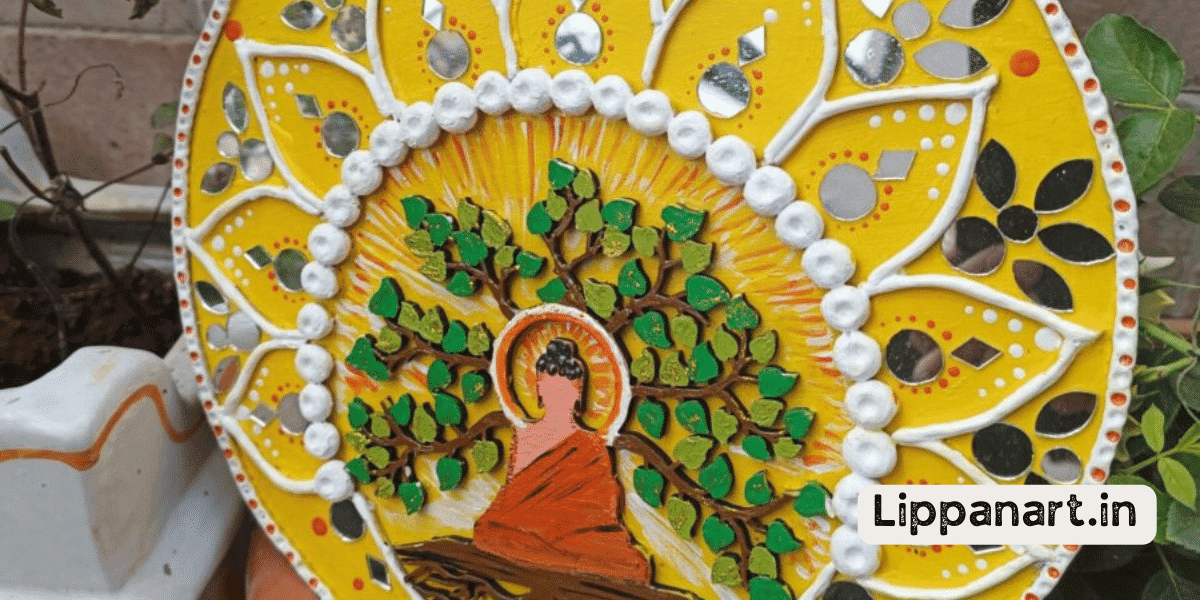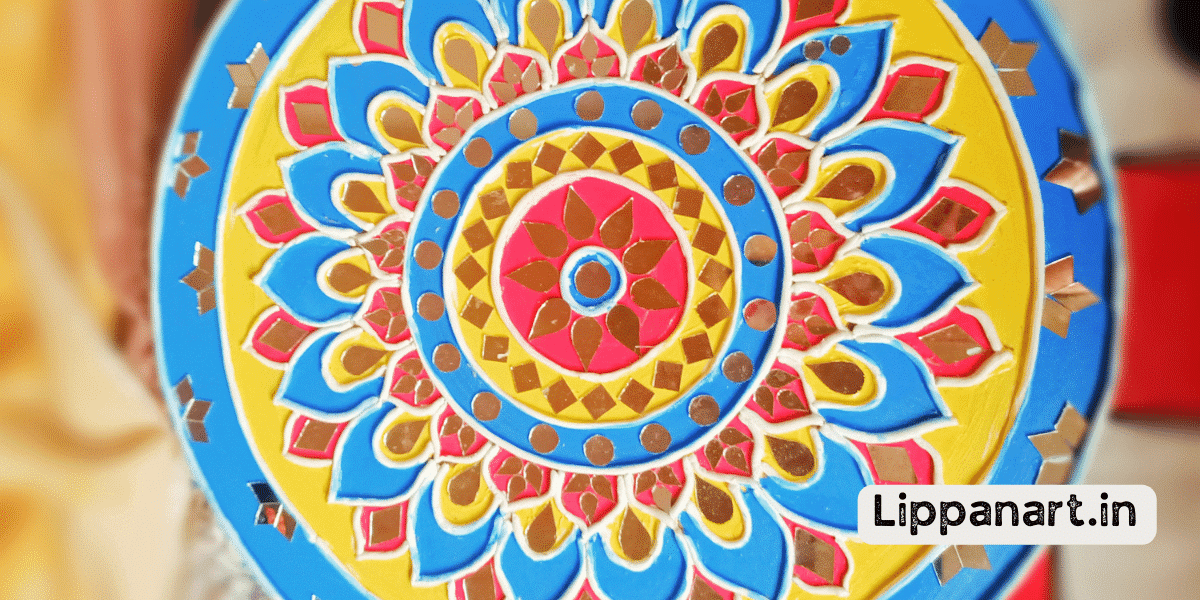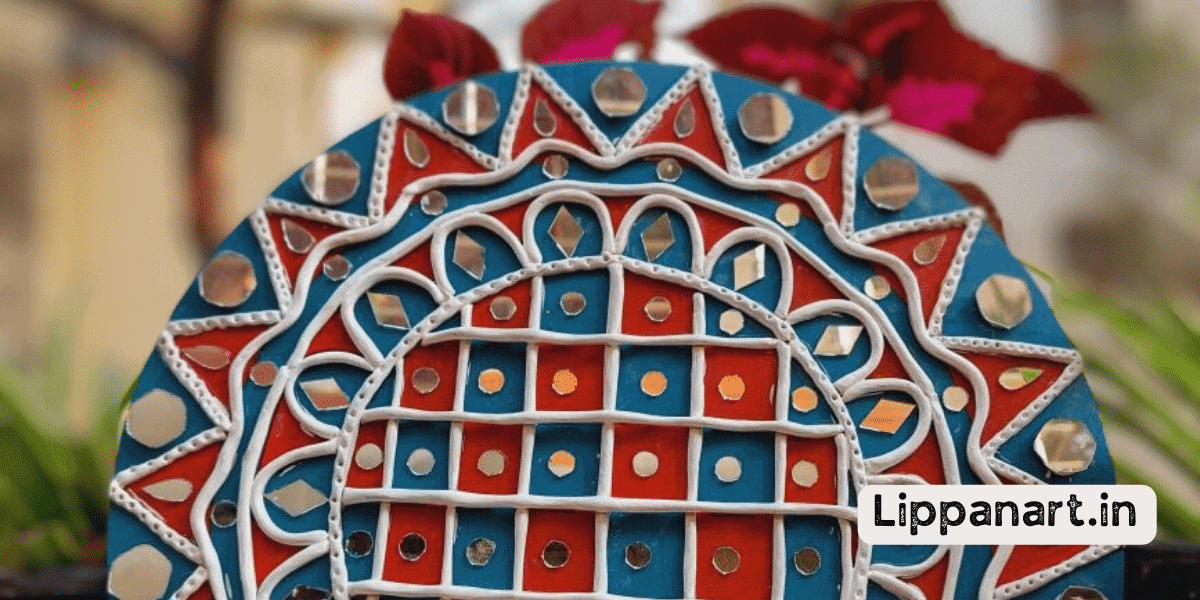Create captivating craftsmanship with colourful, creative lippan art! Mirrors are essential to producing a perfect piece of lippan art, so you must know which ones to use.
Learn the nuances of reflective surfaces, the curvature of concave and convex mirrors, and the balance of plane mirrors. We’ll teach you how to integrate them, enhance visual illusions, and safely secure them to showcase your masterpiece.
Innovate your artistry with the right mirrors and let your lippan art shine!
Understanding Reflective Surfaces
If you want to leverage mirrors in your Lippan art, you must understand the different types available. These three mirrors have unique properties that can help you create reflective art that stands out.
Concave mirrors can be used to create an inverted image. Convex mirrors, on the other hand, can create a wide field of view. Lastly, plane mirrors can create a distortion-free reflection.
Exploring these different types of mirrors can help you create art that captures the perfect reflection.
Leveraging Mirrors in Lippan Art
Mirrors play a key role in lippan art, allowing artists to create intricate, eye-catching designs. To leverage mirrors effectively, acrylic mirrors are the ideal choice. They are lightweight and provide vibrant reflections that give the art an air of sophistication and modernity.
Acrylic mirrors are perfect for lippan art as they can be cut and shaped to fit any design, adding depth and texture. Additionally, they are highly affordable and come in various colours and finishes.
With the right materials, artists can create stunning and dazzling pieces. For lippan art, acrylic mirrors are the perfect tool to bring a unique, eye-catching design to life.
Exploring Types of Mirrors: Understanding concave, convex, and plane mirrors
When exploring mirrors for use in lippan art, it’s important to understand the different types available. This includes concave, convex, and plane mirrors.
Convex mirrors provide a wide visibility angle, allowing the artist to create a unique and expansive reflective surface.
Plane mirrors, on the other hand, offer a flat and clean reflection, allowing the artist to create a crisp image.
Finally, concave mirrors offer a surface that reflects light well, enabling the artist to achieve an accurate and intricate result.
Mirrorwork is an art form that requires innovation and craftsmanship, and utilizing the correct type of mirror is a crucial factor in unlocking creative possibilities.
Learning the fundamentals of each type of mirror will provide the insight needed to create a unique and impactful result.
Harnessing the Curvature: Concave Mirrors
You can create an interesting depth and focus by adding a concave mirror to your lippan art.
Concave mirrors also offer a unique opportunity to play with distortion, as the curvature of the mirror will cause the reflected image to appear differently than it would on a flat surface.
The concave mirror is a great tool to make your lippan art stand out and give it an extra touch of creativity.
Creating Depth and Focus
Mirrors to your lippan art can help create depth and focus, so consider their placement carefully. The clay used to make the base of the art can be worked to form interesting patterns, and various materials like mirrors can be used to enhance the design further. By paying attention to how the mirrors are placed, you can increase the focus and depth of the art.
Incorporate mirrors into the clay to draw attention to specific areas and to bring texture and shine to the piece. If you want to create something unique and innovative, consider using a combination of materials and textures. To make a standout lippan art piece, try experimenting with various shapes and sizes of mirrors. This will help you achieve a truly special and one-of-a-kind creation.
Playing with Distortion
| By manipulating the mirrors, you can distort the lippan artwork and make it stand out. | Kutch | Mirror | Lippan kaam |
|---|---|---|---|
| India | Craftsmanship | Intricate | Embellishment |
| Cultural | Reflective | Unique | Ornamentation |
| Design | Creative | Dynamic | Detail |
Distortion is an integral part of the lippan art process that can be explored through mirrors. Many traditional lippan designs from the Kutch region of India feature highly reflective, intricate mirrors crafted with skill, giving the artwork an unparalleled uniqueness. By playing with the reflective properties of the mirrors and creating dynamic designs, you can bring a creative edge to the artwork and add beautiful ornamentation to the piece. Careful consideration and attention to detail can take the lippan kaam to the next level.
- Editor’s Choice
- Best Seller
- Amazon Choice
Amplifying Elegance: Convex Mirrors
Bringing a beautiful, softening effect to lippan art, convex mirrors expand patterns and light, amplifying elegance and making a statement.
When used, these mirrors open up a world of possibilities, allowing for unique, creative designs that are sure to stand out.
You can create beautiful and intricate art unlike anything else with convex mirrors.
Expanding Patterns and Light
Mirrors in lippan art can amplify patterns and light, creating dynamic visuals. Innovative lippan art can be crafted by experimenting with different materials, such as acrylic paint for vibrant colour, geometric patterns for more texture, and mirror pieces for added depth.
Exploring different techniques is another way to enhance lippan art. This can include cutting and combining shapes, creating illusions of movement, and exploring the effects of shadows.
Enhancing the design is also important in lippan art. This can be achieved by adding unexpected elements, combining patterns and colours, and highlighting light and contrast.
Achieving Softening Effects
Now that we’ve explored how to use expanding patterns and light to create mesmerizing effects in lippan art let’s discuss how to achieve softening effects.
Pencil marks can be used to create a more subtle, blended effect by lightly sketching out the shape of the design.
Acrylic colours can be mixed and blended to create softer transitions between colours.
Camel dung can create a texture that adds a unique, organic depth to the design.
Experiment with these techniques to create a beautiful, softening effect in your next lippan art project.
Achieving Balance: Plane Mirrors
Using plane mirrors, you can create elegant, balanced, and visually stunning lippan art.
To achieve true artistry, the key lies in understanding how to use symmetry and simplicity to reflect and amplify beauty.
With plane mirrors, you can create a masterpiece that is both timeless and unique, allowing you to express your true artistic ability.
Symmetry and Simplicity
Considering the CURRENT SUBTOPIC, symmetry and simplicity are key when choosing mirrors for lippan art. Mirrors are a great way to create intricate designs with minimal effort. For instance, you can sketch the design with pencil markings and then use mirrors to fill in the gaps.
- Mirror art:
- For intricate designs: Use small, asymmetrical mirrors to create a more unique and eye-catching look.
- For a classic look: Use symmetric and larger mirrors to create a cleaner and more traditional look.
- For a modern edge: Use mirrors of varying shapes and sizes to reflect light unexpectedly.
No matter the style, symmetry and simplicity are important in mirror art. You can create an aesthetically pleasing and visually balanced lippan art piece using mirrors of similar shapes and sizes.
Reflecting True Artistry
To create lippan art, one needs to possess genuine artistry. This involves using various mirrors of different shapes and sizes to craft a distinctive and visually appealing design. People often use combinations of circular, square, and diamond-shaped motifs to create a truly captivating piece.
It is important to select the right mirrors for the project. Their reflection needs to be precise and clear. Mirrors that are too dull or have an imperfect surface can ruin the detail of the design.
While some people opt for smaller mirrors to create an intricate pattern, others may use larger ones for a more dramatic effect. The possibilities are endless. With the right combination of mirrors, people can create beautiful works of art that will be admired for generations.
Mirror Integration Techniques
You can create a visually stunning lippan art piece by strategically placing mirrors, blending materials, and transitioning between the two.
With an eye for detail, you can choose the right mirrors and place them strategically within your design.
You can also use mirrors to blend and transition between different materials, colours, and textures, creating a cohesive work of art.
You can create a unique and beautiful lippan art piece with these techniques.
Strategic Placement
Strategically placing the mirrors is key to creating a successful lippan art project. For those looking to innovate, it’s important to consider how the placement of the mirrors affects the final product:
- Functional considerations:
- Ensure the mirror glass craft is securely attached to the wall, preferably with animal dung.
- Consider the wall area that will be reflected in the mirror.
- Design considerations:
- Decide how the placement of the mirrors will affect the surrounding environment.
- Think about how the mirrors will interact with the artwork.
- Aesthetic considerations:
- Use mirrors to create a unique and captivating visual.
- Think carefully about the size and shape of the mirror wall.
- Editor’s Choice
- Best Seller
- Amazon Choice
Blending and Transitioning
Carefully blending and transitioning the mirrors with the artwork is essential to creating a captivating piece.
To ensure the best results, creative experimentation is encouraged regarding the placement and arrangement of mirrors in a lippan art piece.
A pencil can be used to trace the outlines of human figures and other shapes to better understand their size and shape before applying them.
A smooth transition between the mural folk art form and the mirrors is key to the artwork’s success.
The strategic placement of mirrors in the design can highlight different artwork elements and be used to create interesting, multi-dimensional effects.
Enhancing Visual Illusions
You can enhance the visual illusions in your lippan artworks by playing with depth and dimension, multiplicity, and pattern expansion.
Adding depth to your pieces can create a 3D effect that brings your artwork to life.
You can also experiment with multiplicity by using mirrors and reflective surfaces to create multiple images of the same design.
Finally, expanding your patterns can create a stunning visual impact that will draw the viewer in.
With these techniques, you can create a mesmerizing and captivating piece of art.
Depth and Dimension
Consider how the depth and dimension of your mirrors will affect your lippan art. It’s a mixture of clay, mud, and mirror, and the size of the components plays a key role in the overall effect.
When your mirrors are too small, the impact is diminished; when they are too large, it can be overwhelming. So, to achieve a balance of visual impact, you’ll need to find the right mix of mirror tiles.
- Large-scale: Create drama and movement with larger, more defining pieces.
- Medium-scale: Create a subtle, cohesive feel with less-defined, blended pieces.
- Small-scale: Create texture and visual interest with small, intricate pieces.
Crafting your lippan art with the right balance of size and dimension will help you create a unique, stunning visual that reflects your style and vision.
Utilizing a mixture of sizes, textures, and shapes of mirror tiles will give you the perfect platform to explore your creativity and develop truly innovative works of art.
Multiplicity and Pattern Expansion
You can create dynamic and eye-catching designs with tiles and mud by playing with multiplicity and pattern expansion. You can expand the patterns using animal forms, intricate patterns, and raw materials. This technique adds a unique complexity and visual appeal to a piece, making it stand out.
You can also use this technique to create a three-dimensional effect, adding depth and dimension to the artwork. The possibilities of pattern expansion are limited only by your imagination. You can create unique and beautiful artwork that reflects your style with a little creativity.
With the use of mirrors, you can even add more depth to the piece, creating a truly mesmerizing and captivating artwork.
Finding the Right Mirror
When searching for the right mirror to use in lippan art, there are a few important considerations:
- Size and proportion: You’ll want to find a mirror that is the right size for the artwork and in the correct proportion. This will help ensure the mirror complements the overall design and doesn’t overpower or underwhelm it.
- Quality and clarity: It’s important to find a mirror that is of high quality and clarity. Ensuring your artwork looks its best and the mirror accurately reflects light and images is important. A mirror with imperfections or distortions may detract from the overall effect of your lippan art.
- Effect creation: Look for a mirror that will help you create the effect you’re looking for. Whether you want a mirror that enhances the shine and sparkle of the artwork or one that creates interesting reflections and patterns, choose a mirror that aligns with your artistic vision.
Considering these factors will help you find the perfect mirror for your lippan art, allowing you to create a visually stunning and cohesive piece.
Size and Proportion
When choosing mirrors for your lippan art, consider size and proportion. When deciding on the right dimensions, it is important to consider the piece’s overall design.
Finding the Right Materials
- White acrylic paint or dung
- The mirror wall plate of the desired size
- Non-toxic glue
Assessing the Proportions
- Measure the wall or the chosen surface
- Calculate the number of mirrors needed to fit the design
- Cut the mirror plate to the desired size
Crafting the Lippan Art
- Place the mirrors on the surface
- Secure the mirrors with glue
- Apply the white acrylic paint or dung to create a unique pattern
- Editor’s Choice
- Best Seller
- Amazon Choice
Quality and Clarity
It’s important to ensure the quality and clarity of the mirrors when crafting lippan art. Choosing the right type of mirror is essential to create beautiful, intricate, and unique pieces.
Mud mirror art is popular due to its affordability and ease of use. It provides quality and clarity, though it is less durable than glass mirrors.
Glass mirrors, on the other hand, offer a higher level of clarity. They are a great option if you want your lippan art to have a more polished and professional look.
Moon craft mirrors, on the other hand, provide a more artful and whimsical look to your lippan art. Adding them can bring a touch of magic and uniqueness to your creations.
Whatever type of mirror is used, it’s important to consider the quality and clarity for the best results. Creating remarkable lippan art is possible with the right materials and knowledge.
Securing Mirrors Safely
Securing your mirrors safely is an important part of creating lippan art. To ensure your mirrors stay in place and aren’t damaged, consider your adhesive choices carefully and find the best option for your project.
Various options, from liquid nail adhesives to double-sided tape, are available to ensure your mirrors stay securely in place and prevent damage.
Adhesive Choices
When choosing an adhesive for your lippan art, consider the weight of the mirrors you use. A heavier mirror will require a stronger adhesive to ensure it remains secure. Here are the most popular adhesive choices:
Glue:
- Super Glue: An excellent choice for small, lightweight mirrors.
- Gorilla Glue: Perfect for heavier mirrors.
- Liquid Nails: The strongest choice for extra-heavy mirror work.
Tape:
- Hot Glue: A great choice for rectangular acrylic craft mirrors.
- Double-Sided Tape: Perfect for lightweight mirrors.
- Masking Tape: Ideal for heavier mirrors.
No matter the adhesive you choose, lippan art requires precision and creativity to make it shine. The right adhesive choices can ensure the mirror work remains secure and beautiful.
Preventing Damage
To ensure your lippan art remains beautiful, it’s important to take preventative measures to protect the mirrors from damage. You may choose between rectangle acrylic craft mirrors and circular mirrors as you explore the mud and mirror work world. With either option, there are a few steps to prevent damage to your mirrors and art.
| Mirror Type | Cushioning | Wrapping |
|---|---|---|
| Rectangle | Use bubble wrap. | Wrap with cloth and tie with string. |
| Circular | Place in foam-lined box. | Wrap with tissue paper and secure with tape. |
To protect the edges of the mirrors, use cushioning like bubble wrap for rectangular mirrors and foam-lined boxes for circular mirrors. When wrapping the mirrors, use cloth for rectangular mirrors and tissue paper for circular mirrors. Secure the wrapping with string for rectangular mirrors and tape for circular mirrors.
Showcasing Your Reflective Masterpiece
Considering the lighting to showcase your reflective masterpiece to its best effect is important. Different lighting can greatly impact how your artwork is perceived, so experiment with lighting angles, fixtures, and shades to discover what works best for your piece.
Feel free to try something new – you may be surprised by the results! With the right lighting, your lippan art could be a show-stopping centrepiece.
Lighting Considerations
When selecting mirrors for your lippan art, you’ll need to consider lighting. Mirrorwork should be illuminated to enhance the art’s visual appeal. To achieve this, you have three options:
- Traditional materials: Utilize metal, glass, and wood to reflect and amplify light for a classic, timeless look.
- Modern materials: Choose acrylic, vinyl, and plastic to create a more contemporary atmosphere.
- Lighting considerations: Consider the light source’s location, angle, and intensity to create the desired atmosphere.
Innovative lighting strategies can turn everyday materials into a unique, reflective masterpiece. With careful thought and creative use of modern and traditional materials, you can craft a lippan art display that will capture the attention of any audience.
Frequently Asked Questions
What Is the Best Way to Clean a Mirror Used in Lippan Art?
To clean your lippan art mirror, use warm water, mild soap, and a soft cloth. Move slowly and steadily for the best results. It’s a simple step that makes a big difference!
What Are the Different Types of Framing Options Available for Mirrors?
Explore the various framing options for mirrors to create unique, innovative pieces. From classic wood to sleek metal, there’s a style to match any desired aesthetic. Try something new with creative combinations of framing materials. Have fun and be creative!
What Types of Materials Can Be Used for Mirror Integration Techniques?
Mirror integration techniques can involve any material that allows light to reflect – glass, metal, plastic, and even fabric. Spice up your Lippan Art with a hint of shimmer and shine by experimenting with different materials – a feat of creativity sure to dazzle!
How Can I Get the Best Results Using a Mirror in Lippan Art?
Experiment with different materials, techniques and angles to get the best results when using a mirror in lippan art. Play with light and colour to bring a unique twist to your art. Utilize the creative potential of the mirror to achieve a truly innovative effect.
Are There Any Special Safety Considerations to Remember When Working With Mirrors?
You’re in for a real treat when you experience the mesmerizing effects of lippan art with a mirror. But make sure you handle it with care; safety is paramount! Don’t take any chances – use gloves and eye protection to ensure a fun and unforgettable experience.
Conclusion
You’ve come a long way in finding the perfect mirrors for your lippan art. Choosing the right curvature and size for your project can be daunting, but with the right knowledge and care, you can create something stunning.
As the saying goes, ‘A picture is worth a thousand words,’ and with the right mirrors, you can craft a masterpiece that will speak for itself.
















